Introduction
Monsoon made its way to Punjab. Giving a desired escape from the intense heat of summer. The monsoon season brings about celebrations for many individuals. This year it comes with a cautionary message. The meteorological branch has alerted eleven districts in Punjab. It’s time to examine what this signifies and the potential consequences of life. We should investigate this and its potential impact on the way people reside in those regions.
What is a Yellow Alert?

The weather condition is swear, and it is truly declared by the Meteorological Department. A Yellow Alert is a serious indication of severe weather conditions. While there are no quick threats. This is a protector against any weather-related effects down the road. In this condition, the alerts to locals and impacted areas to get ready for strong rains, storms, and potential disruptions. This may effect the agricultural industries too.
The Affected Districts
The areas under the Yellow Alert include Amritsar, Ludhiana, Jalandhar, Patiala, Gurdaspur, Hoshiarpur, Firozpur, Pathankot, Bathinda, Sangrur, and Mohali. These districts are likely to experience significant rainfall, which could lead to localized flooding and affect daily activities. However, these cities also faced severe storms many times in the past.
Impact of Heavy Rains

The rainfall alert for these districts in Punjab brings both promises and potential problems. Rains are beneficial but the heavy rains may harm the environment. Here are some key impacts to consider:
Agricultural Dynamics

The agricultural sector looks forward to the monsoon. It nourishes the crops and rejuvenates the soil. However, an excess of rain can also have adverse effects, such as water logging and root damage to crops.
Urban Life Disruptions
Urban areas can bear the brunt of heavy rains. Roads can become waterlogged, leading to traffic snarls and delays. Power outages are also common as electricity infrastructure struggles to cope with the increased moisture and wind.
Health Concerns
As the monsoon starts, some diseases like waterborne and vector-borne increase especially in infants. The stagnant water or water sewage water bodies thrive in mosquitoes. That may concern about dengue and malaria. Residents need to maintain hygiene and take preventive measures.
Safety Tips

In the monsoon, there is cooling showers and green lands. Flowers start to bloom and the freshness revolves all around. During this charm is essential to be prepared to remain safe.
Remain Up to Date
Monitor weather conditions using dependable resources, such as weather applications and regional news networks. Making well-informed decisions and acting promptly are aided by this.
Travel Wisely
Steer clear of pointless travel during strong downpours. If you must leave, make sure your route avoids regions that are flooded and drive carefully.
Medical Measures
Apply insect repellent and maintain dry, clean living areas to reduce the chance of contracting infections from mosquitoes. Be especially mindful of food hygiene and the quality of your drinking water.
Monsoon Cautions
While Punjab experiences a dazzling whirlwind of life and optimism during the monsoon. The rainfall alert across the 11 districts serves as a sobering reminder to respect the might of nature. Residents can protect themselves and their communities while also taking advantage of the beauty of the season by being aware and ready.
Final Thoughts
Punjab has both benefits and drawbacks when the monsoon arrives. On the one hand, it lowers temperatures and rekindles the region’s agricultural heartbeat. Conversely, it calls into question the public health and infrastructure’s resiliency. Being ready and careful is of the utmost importance as Punjab moves through this monsoon season with a Yellow Alert. Therefore, remember to put safety first even while you enjoy the refreshing breeze and the beautiful scenery.









